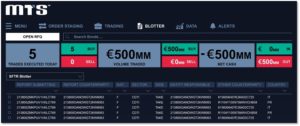The European Union’s Securities Financing Transactions Regulation, which introduces challenging reporting requirements, goes live for broker-dealers in six months time but the market is still waiting for the final specifications from regulators.
SFTR requires all securities financing transactions including repos, securities lending and margin lending trades, to be reported to an authorised trade repository the day after a trade using a unique transaction identifier. The data, consisting of approximately 150 fields, should allow supervisors to monitor market developments such as the build-up of leverage in the financial system. In addition, there are new disclosure obligations and collateral reuse obligations.

Val Wotton, managing director, product development and strategy, derivatives and collateral management at DTCC, the US market infrastructure, said in a statement on 12 October that the day marked six months until the introduction of SFTR for broker-dealers and a year until the implementation date for asset managers
“While the broker-dealers have made good progress in their readiness for SFTR implementation, the smaller and medium-sized asset managers have much further to go in their preparations in order to be compliant in time,” added Wotton.
Buy-side firms that lack the resources to build and manage technology for their own transaction reporting can delegate to their broker but issues have emerged around areas such as collateral reuse.
“This is why buy-side firms need to prioritise SFTR readiness now, to ensure that they have ample time to implement the optimal model for their needs, which may include assisted reporting, whereby service providers help buy-side firms to fulfil their obligations while easing the burden for dealers,” said Wotton.
Reporting challenges
The new reporting requirements are challenging for a market which has traditionally been very manual.
However, James Stacey, regulatory business analyst, at London Stock Exchange’s clearing house LCH, said in a media briefing that the industry and regulators have learnt from the implementation of Emir.
The Emir regulation went live in the EU in 2014 and introduced new reporting requirements for centrally cleared derivatives to authorised trade repositories. There were issues with poor data quality and lack of reconciliations between the repositories.

Stacey said: “For SFTR there are strict matching criteria applicable to reporting, such as those applicable to collateral valuations, and the approach of phasing in reconcilable fields means matching does not all have to happen on day one, giving firms time to resolve issues with their reporting even after the official go-live dates.”
In addition, for cleared trades, central counterparty clearing houses will be holders of the golden source of trade data so disputes should be significantly reduced.
“CCPs are not required to go live with SFTR reporting until Phase II in July next year but LCH plans to go live in the first phase in April to improve matching rates for our members from day one,” he said.
LCH initially launched a sponsored clearing model in 2017 to give buy-side firms access to cleared repo and Stacey continued that interest has been growing. This is live for sterling repo in LCH Ltd in London and will soon be launched for euro repo in LCH SA in France.
“This model will also provide buy-side firms with access to CCP reporting which should ease the burden of information gathering,” added Stacey.

Axel Pierron, co-founder and managing director at capital markets consultancy Opimas, said in a report that a greater reliance on services provided by CCPs could have a profound impact on securities lending by reducing the need for intermediation by prime brokers. He wrote that two CCPs offers such services, Deutsche Börse’s Eurex Clearing in Europe and the OCC in the US.
“While these services have been available for quite some time, the volume has not yet materialized, as opposed to what has happened with repo transactions where we’ve witnessed a clear uptake,” he said.
Pierron continued that Eurex announced in June this year that BNY Mellon was the first agent lender to centrally clear securities transactions on behalf of a buy-side client through its lending platform. “This demonstrates that there is a long way to go before such practices become the market standard, if ever,” he said.
Technology
The European Commission adopted SFTR in December last year but market participants are still waiting for the Level 3 text with the final regulatory specifications. LCH has sent reporting specifications to members and connectivity testing is due to begin in January, subject to the publication of Level 3 text.
In order to make trade reporting easier, UnaVista has launched assisted reporting. LSEG’s regulatory reporting unit will validate, cleanse and augment datasets, although ultimate responsibility still remains with the client.
SFTR requires a Unique Trade Identifier (UTI) to be used when #RegulatoryReporting but which party is responsible for its creation? This and 5 critical factors for #SFTR are discussed here https://t.co/QcnoTHQK46 in this article by Sarah Peaston @RegulatoryGove1 pic.twitter.com/WFpbTKmBXb
— Regulatory Reporting (formerly UnaVista) (@LSEG_Reporting) October 9, 2019
Catherine Talks, product manager at Unavista, said in a media briefing: “With such an extensive reporting obligation firms are taking this opportunity to review legacy systems and change operational models to adhere to the T+1 reporting requirement. There is innovation happening in the market and we are seeing a rise of partnerships to assist firms in their reporting, we have a number of models that work alongside software providers to help firms with their reporting obligations.”
Although reporting may be challenging to implement, Talks continued that the market could also eventually benefit from opportunities to generate analytics from the data, such as trends within a peer group or certain risks associated with particular activities.
Opimas said SFTR represents a significant opportunity for securities lending software solution providers to deliver reporting services to market participants. In the study, Sizing Up the Securities Lending Market and Its Solution Providers, the consultancy estimated that post-trade solutions market in securities lending will grow from $350m this year to nearly $400m in 2021.
Shift to electronic trading
Tom Harry, product manager MTS, said at the media briefing that cleared inter-dealer repo trades are executed electronically. However, many exotic trades are still executed manually, so LSEG’s fixed income trading venue is trying to facilitate a move to electronic trading.
“Dealer to client trading is typically executed by voice, so SFTR is a significant hurdle for many participants,” said Harry. “To help facilitate the transition, MTS is offering an SFTR blotter for both bilateral and cleared trades which includes the required reporting fields.”

Harry said MTS is also seeing changes in customer behaviour, particularly with regard to processed trades. “These are negotiated bilaterally but then executed on a venue to allow straight-through-processing and reporting,” he said.
In order to increase electronic trading, Hudson Fintech this month launched a front office technology platform for sell-side and buy-side institutions trading in the repo markets.
The firm said in a statement that it was established to help market participants meet the need for increased regulatory reporting and transparency, improved risk management processes, and balance sheet constraints.
“Regulators around the world demand increased data control and reporting, leading to many financial institutions reviewing their outdated legacy systems, typically using multiple technology bolt-ons, which limit the flow and efficiency of trading operations,” said the statement.
Hudson said its core technology is based on an advanced system architecture, known as Entity-Component-System. ECS architecture has fewer interdependencies so it is more flexible, and faster and cheaper to develop. Code is extensively re-used with continuous automated testing so less time is spent on manual regression testing. The firm said it aims to reduce the time taken to upgrade systems and cut typical licence fees by up to 50%.
